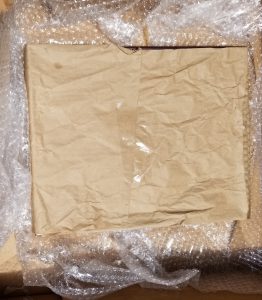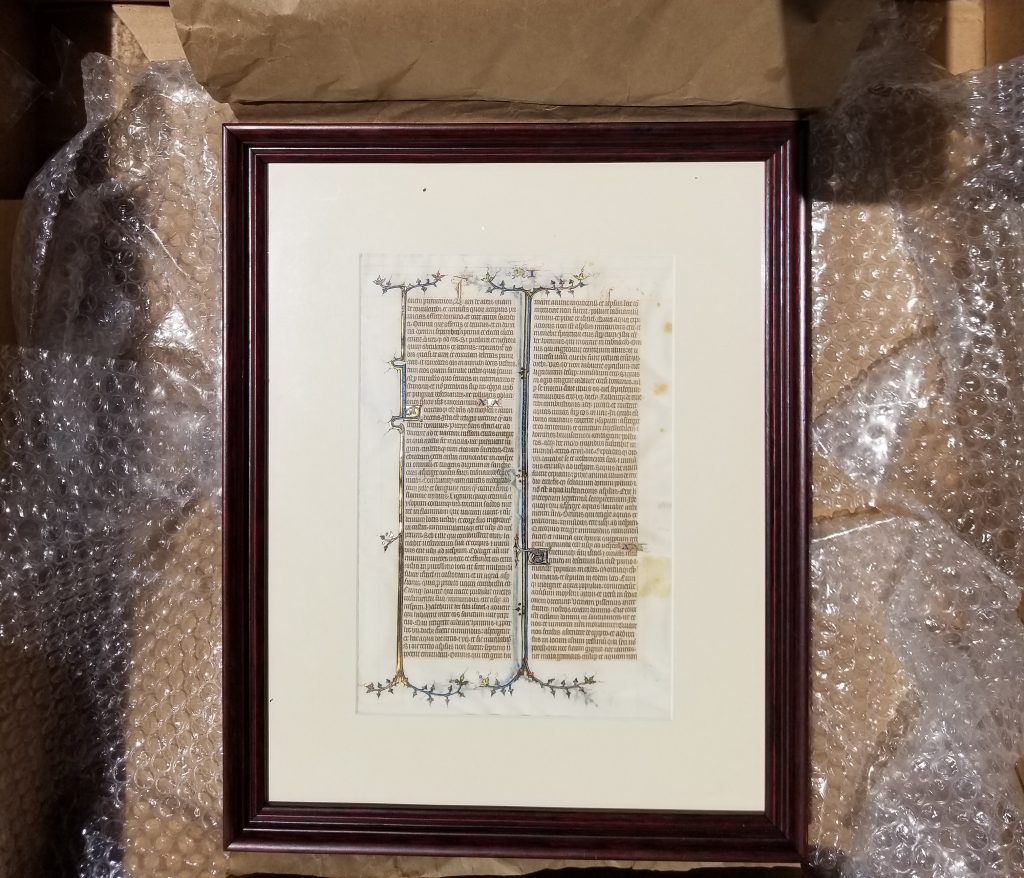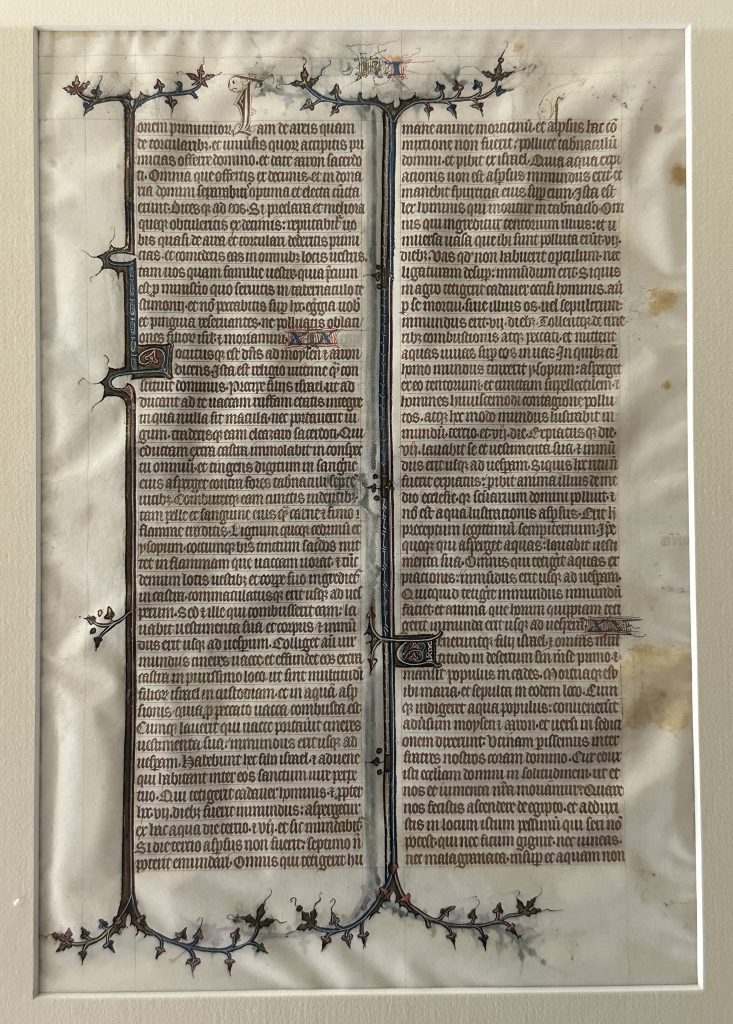A Latin Vulgate Bible Leaf
in the Collection of Jennah Farrell
Part of the Book of Numbers
laid out in double columns of 46 lines in Gothic Script
Visible area within mat:
maximum circa 24.1 cm. tall × 16.3 cm. wide
(circa 9 7/8 in. tall × 6 7/8 in. wide)
< ruled writing area circa 18.7 × 12.5 cm.
(7 3/4 × 4 7/8 in.)
[Posted on 11 September 2024]
After introducing you to the RGME “Lending Library”, we turn to a “New Loan” mentioned in that blogpost. Sent to the RGME for study, the loan comprises a single vellum leaf from a medieval Latin Vulgate Bible manuscript which the present owner acquired in its frame among a former owner’s belongings.
The new owner approached the RGME Director on the strength of one of our blogposts. The leaf has been sent on loan to the RGME in June 2024. With permission, we report results as we continue to study the leaf and its context. Later we will remove the leaf from its modern frame and reveal more discoveries.
First Steps

Private Collection. Framed Bible Leaf in its Wrapping for Transit to the RGME in July 2024: View upon arrival in unpacking the leaf. Photograph by Mildred Budny.
Work on the leaf after it had safely arrived, in secure packing, had to wait while disruptions to the RGME website and a cluster of other unexpected issues intervened, requiring attention. Resuming work (as you can see, our website is back in accessible working order), we begin our report on the leaf with this blogpost. It sets the scene and shows first photographs of the leaf still in its frame, to introduce the leaf to you.
At present, the leaf remains in its frame, while we study its visible features and explore its context. Then we will, with permission, remove the leaf from the frame, to photograph and study its other side and outer edges now hidden below the windowed opening of the mat and by the back of the frame.
The Visible Text: Recto or Verso?
The leaf stands in the windowed glass frame in which it reached its current owner. On partly puckered
vellum, the text in Latin presents part of the Old Testament
Book of Numbers in the
Vulgate Version.

Collection of Jennah Farrell, Manuscript Leaf in Frame: Front, emerging from packaging upon arrival for study. Photograph by Mildred Budny.
The back of the frame has few identifying features. Besides the metal hanging wire and its pair of mounts, its black paper covering has the traces of a removed label formerly centered at one end and a companion nail taped off-center to the opposite end.

Collection of Jennah Farrell, Manuscript Leaf: Back of Frame emerging from packaging. Photograph by Mildred Budny.
Through the glass of the frame, most of one side of the leaf can be seen, with its outer edges on all sides covered to some extent by the windowed mat.
The visible extent of the leaf within the mat measures a maximum of circa 24.1 cm. tall × 16.3 cm. wide (circa 9 7/8 in. tall × 6 7/8 in. wide). The ruled writing area measures circa 18.7 × 12.5 cm. (7 3/4 × 4 7/8 in.). As presented to view, the full extent can be seen of the two columns of script and most of the appendages and additional elements which accompany it as navigation aids. The latter include the running title, inset chapter numerals, and decorative embellishments.

Collection of Jennah Farrell, Manuscript Leaf in Mat. Photograph by Jennah Farrrell.
The Text, Decoration, and Layout
Written in Gothic script, the text in Latin is laid out in two columns of 46 lines each: columns a at the left and b at the right. To the left of each column stands a decorative vertical bar extending the full height of the column and reaching into the upper and lower margins of the page, with foliate extensions branching sideways in both directions.
Inset decorative 2-line text initials, set in sub-rectangular gold frames, attach to the right-hand sides of the columnar bars, with one per column. With the identifying Roman chapter-numbers written in Capitals against decorated backgrounds at the ends of the preceding lines, these initials open Chapters XIX and XX in the Old Testament
Book of Numbers.
In the top line of each column, an extended letter rises to a leftward-facing head in profile: animal in column a and male with extended pointed cap in column b.

Collection of Jennah Farrell, Manuscript Leaf in Mat: top left. Photograph by Jennah Farrrell.
The running title at the top, set within parallel lines ruled in drypoint, identifies the text with “RI” in Capitals. Expecting the first part of the word “NUME” on the facing verso of the original manuscript, this would be the recto.

Collection of Jennah Farrell, Manuscript Leaf in Frame: Top right. Photograph by Jennah Farrrell.
The text on the page starts in Numbers 18:27 of the Latin Vulgate version: “. . . [oblati]onem primitovorum. Tam de areis quam“. “XIX” marks the start of Numbers 19: “Locutus est dominus ad moysen“. There then follows a long list of rules about becoming ‘unclean’ after touching a dead body.
“XX” marks the start of Numbers 20: “Veneruntque filii israel“. The page ends in 20:5 “. . . et aquam non [/ habet ad bibendum]”, expected to continue on the verso. The last line has “malagranata“, the Latin for “pomegranates”.
The left-facing man’s head at the top of col.b does not appear to be at a significant point in the text. It stands in the middle of 19:13 against an extended tall-s of “asp[er]sus“. The text:
[13] omnis qui tetigerit humanae animae morticinum et aspersus hac commixtione non fuerit polluet tabernaculum Domini et peribit ex Israhel quia aqua expiationis non est aspersus inmundus erit et manebit spurcitia eius super eum
[13] Every one that toucheth the corpse of a man, and is not sprinkled with mixture, shall profane the tabernacle of the Lord, and shall perish out of Israel: because he was not sprinkled with the water of expiation, he shall be unclean, and his uncleanness shall remain upon him.
Show-Through and the Other Side
Show-through from the verso reveal features of ink and pigment which diverge from those on the recto. For example:
1) parts of the running title likewise in Capitals (the letters NUME would be expected);
2) a vertical bar down the intercolumn edging column b, but not one for column a
3) an inset 2-line initial with sub-rectangular frame in column b at the start of lines 23–24 (presumably the q for Quod for Numbers chapter 21); and
4) foliate extensions across most of the lower margin, but not reaching into its span below the inner or outer margins, unlike the formation from the bar for column a on the recto.
Let us see what becomes revealed with the leaf is removed from its frame. That step comes later, to be revealed in another blogpost.
Meanwhile, we could take as educated ‘predictions’ of what to expect such evidence as the show-through of features from the verso and the place in the course of the known text where column b on the recto breaks off mid-phrase. This process could serve as a useful teaching exercise.
For example, the other side holds evidence which can become available to view once outside the frame. It could correct or confirm our conjectures about its features as we examine the visible recto before then.
How accurate are these conjectures? Let’s see!
More to Come
Watch this space. A next blogpost would reveal more as our research continues.
Update: See our next blogpost and join a pair of Workshops on “Looking at Manuscripts”, dedicated to this Leaf. Would you like to help us to identify it? Come and learn how!
Comments? Join the Journey!
Do you recognize this manuscript? Are you familiar with other leaves from it? Please let us know.
Please Contact Us or visit
Would you like to help? Donations and contributions, in funds or in kind, are welcome and easy to give. Given our low overheads, your donations have direct impact on our work and the furtherance of our mission. For our Section 501(c)(3) nonprofit educational organization, your donations may be tax-deductible to the fullest extent permitted by law. Thank you for your support!
We look forward to hearing from you.
*****






